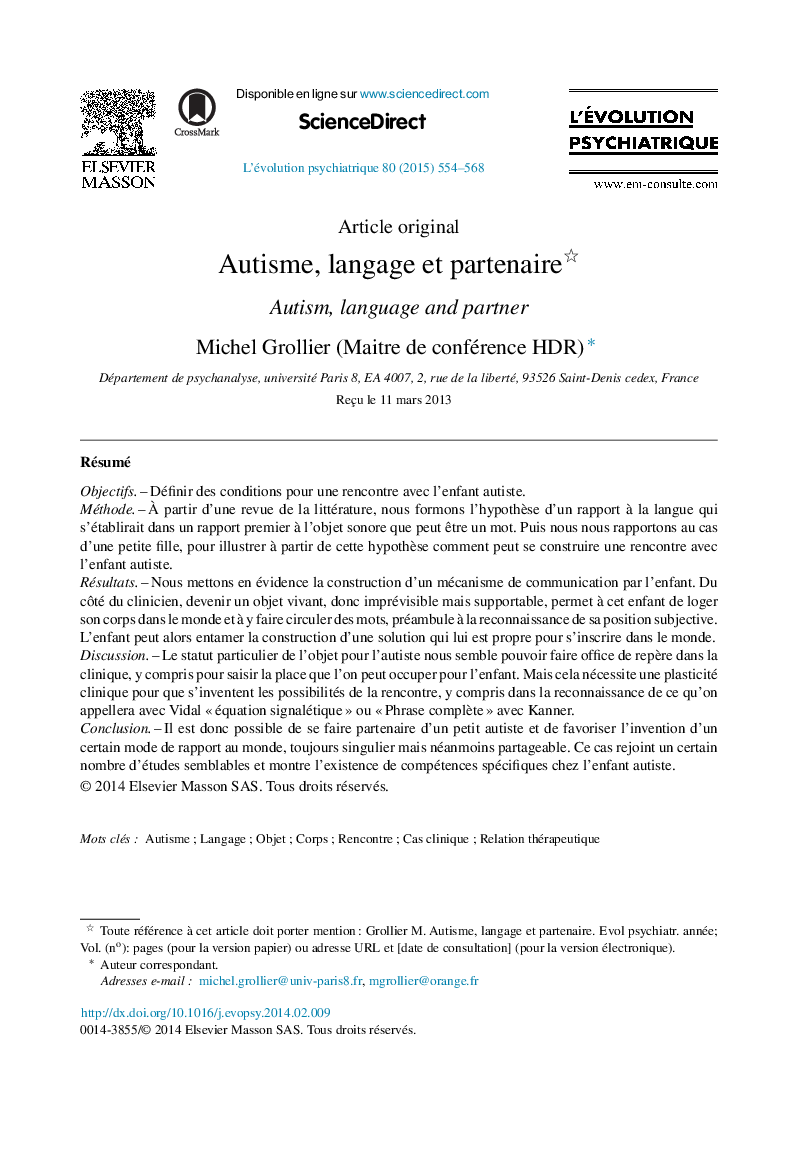| کد مقاله | کد نشریه | سال انتشار | مقاله انگلیسی | نسخه تمام متن |
|---|---|---|---|---|
| 908528 | 917182 | 2015 | 15 صفحه PDF | دانلود رایگان |
RésuméObjectifsDéfinir des conditions pour une rencontre avec l’enfant autiste.MéthodeÀ partir d’une revue de la littérature, nous formons l’hypothèse d’un rapport à la langue qui s’établirait dans un rapport premier à l’objet sonore que peut être un mot. Puis nous nous rapportons au cas d’une petite fille, pour illustrer à partir de cette hypothèse comment peut se construire une rencontre avec l’enfant autiste.RésultatsNous mettons en évidence la construction d’un mécanisme de communication par l’enfant. Du côté du clinicien, devenir un objet vivant, donc imprévisible mais supportable, permet à cet enfant de loger son corps dans le monde et à y faire circuler des mots, préambule à la reconnaissance de sa position subjective. L’enfant peut alors entamer la construction d’une solution qui lui est propre pour s’inscrire dans le monde.DiscussionLe statut particulier de l’objet pour l’autiste nous semble pouvoir faire office de repère dans la clinique, y compris pour saisir la place que l’on peut occuper pour l’enfant. Mais cela nécessite une plasticité clinique pour que s’inventent les possibilités de la rencontre, y compris dans la reconnaissance de ce qu’on appellera avec Vidal « équation signalétique » ou « Phrase complète » avec Kanner.ConclusionIl est donc possible de se faire partenaire d’un petit autiste et de favoriser l’invention d’un certain mode de rapport au monde, toujours singulier mais néanmoins partageable. Ce cas rejoint un certain nombre d’études semblables et montre l’existence de compétences spécifiques chez l’enfant autiste.
ObjectivesDefine conditions for an encounter with the autistic child.MethodsFrom the state-of-the-art, we have hypothesized that a link in the language would be established in a primary relationship in the sound object, such as a word. We then report the case of a young girl to illustrate how a meeting with the autistic child can build itself.ResultsWe highlight the elaboration of a process of communication by the child. For the clinician, to become an alive, unpredictable but bearable object, allows this child to live his/her body in the world and to be able to circulate the words, prelude in the recognition of its subjective position. Then the child can begin the construction of his/her own answer to join the world.DiscussionThe particular status of the object for the autistic seems to act as a reference in clinical practice, and takes the place we could have for the child. Nevertheless, it requires a clinical plasticity allowing the invention of the possibilities of meeting, including in the recognition of what we shall call with Vidal the “descriptive equation” or “complete sentence” with Kanner.ConclusionThus, it is possible to be a partner of a small autistic child and to favor the invention of a certain mode of relation to the world, always singular but nevertheless shareable. This case study joins a number of studies and shows the existence of specific skills in the autistic child.
Journal: L'Évolution Psychiatrique - Volume 80, Issue 3, July–September 2015, Pages 554–568
